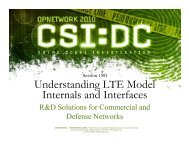Understanding TCP/IP Model Internals and Interfaces
Understanding TCP/IP Model Internals and Interfaces
Understanding TCP/IP Model Internals and Interfaces
You also want an ePaper? Increase the reach of your titles
YUMPU automatically turns print PDFs into web optimized ePapers that Google loves.
1508 <strong>Underst<strong>and</strong>ing</strong> <strong>TCP</strong>/<strong>IP</strong> <strong>Model</strong> <strong>Internals</strong> <strong>and</strong> <strong>Interfaces</strong><br />
Summary<br />
We have seen how packets are retransmitted <strong>and</strong> the congestion window is calculated depending on<br />
a selected <strong>TCP</strong> flavor.<br />
We can observe that <strong>TCP</strong> Reno with ECN support outperforms <strong>TCP</strong> SACK <strong>and</strong> New Reno, while<br />
Reno has the worst response time for this case. Moreover, Reno is even “slower” than Tahoe. This<br />
may be surprising, because Reno was designed as an improvement over Tahoe. However, this is<br />
because Reno is optimized for networks with a small packet discard ratio, whereas we presented a<br />
case in which multiple packets were dropped from the same window of data. The reason that <strong>TCP</strong><br />
Reno with ECN support offers the best response time is that in this case no packets are actually<br />
dropped.<br />
Note:<br />
For a comparison, we have also executed simulations in which only one segment is dropped<br />
(segment 23). In this case, Reno should perform better than Tahoe. That this is indeed the case can<br />
be seen from the graph below.<br />
END OF LAB 2<br />
CONFIDENTIAL – RESTRICTED ACCESS: This information may not be disclosed, copied, or transmitted in any format without the prior written consent of OPNET Technologies, Inc.<br />
© 2010 OPNET Technologies, Inc.<br />
22
















